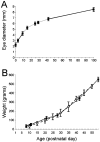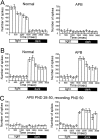Cortical cell orientation selectivity fails to develop in the absence of ON-center retinal ganglion cell activity
- PMID: 10684893
- PMCID: PMC2666976
- DOI: 10.1523/JNEUROSCI.20-05-01922.2000
Cortical cell orientation selectivity fails to develop in the absence of ON-center retinal ganglion cell activity
Abstract
Neuronal activity is necessary for the normal development of visual cortical cell receptive fields. When neuronal activity is blocked, cortical cells fail to develop normal ocular dominance and orientation selectivity. Patterned activity has been shown to play an instructive, rather than merely permissive, role in the segregation of geniculocortical afferents into ocular dominance columns. To test whether normal patterns of activity are necessary to instruct the development of cortical orientation selectivity, we studied ferrets raised without ON-center retinal ganglion cell activity. The ON-center blockade was produced by daily intravitreal injections of DL-2-amino-4-phosphonobutyric acid (APB). Effects of this treatment on the development of orientation selectivity in primary visual cortex were assessed using extracellular electrode recordings and optical imaging. In animals raised with an ON-center blockade starting after visual cortical cells are visually driven but still poorly tuned for orientation, cortical cell responsivity was maintained, but no maturation of orientation selectivity was seen. No recovery of orientation tuning was seen in animals treated with APB during the normal period of orientation development and then allowed several months of development without treatment. These results suggest that patterns of neuronal activity carried in the separate ON- and OFF-center visual pathways are necessary for the development of orientation selectivity in visual cortical neurons of the ferret and that there is a critical period for this development.
Figures







Similar articles
-
Suppression of cortical NMDA receptor function prevents development of orientation selectivity in the primary visual cortex.J Neurosci. 2001 Jun 15;21(12):4299-309. doi: 10.1523/JNEUROSCI.21-12-04299.2001. J Neurosci. 2001. PMID: 11404415 Free PMC article.
-
Disruption of orientation tuning in visual cortex by artificially correlated neuronal activity.Nature. 1997 Apr 17;386(6626):680-5. doi: 10.1038/386680a0. Nature. 1997. PMID: 9109486
-
No ON-OFF maps in supragranular layers of ferret visual cortex.J Neurophysiol. 2002 Oct;88(4):2163-6. doi: 10.1152/jn.2002.88.4.2163. J Neurophysiol. 2002. PMID: 12364539 Free PMC article.
-
Dynamics of orientation selectivity in the primary visual cortex and the importance of cortical inhibition.Neuron. 2003 Jun 5;38(5):689-99. doi: 10.1016/s0896-6273(03)00332-5. Neuron. 2003. PMID: 12797955 Review.
-
Recording and manipulating the in vivo correlational structure of neuronal activity during visual cortical development.J Neurobiol. 1999 Oct;41(1):25-32. doi: 10.1002/(sici)1097-4695(199910)41:1<25::aid-neu5>3.0.co;2-#. J Neurobiol. 1999. PMID: 10504189 Review.
Cited by
-
Epibatidine blocks eye-specific segregation in ferret dorsal lateral geniculate nucleus during stage III retinal waves.PLoS One. 2015 Mar 20;10(3):e0118783. doi: 10.1371/journal.pone.0118783. eCollection 2015. PLoS One. 2015. PMID: 25794280 Free PMC article.
-
Principles underlying sensory map topography in primary visual cortex.Nature. 2016 May 5;533(7601):52-7. doi: 10.1038/nature17936. Epub 2016 Apr 27. Nature. 2016. PMID: 27120164 Free PMC article.
-
Increasing Spontaneous Retinal Activity before Eye Opening Accelerates the Development of Geniculate Receptive Fields.J Neurosci. 2015 Oct 28;35(43):14612-23. doi: 10.1523/JNEUROSCI.1365-15.2015. J Neurosci. 2015. PMID: 26511250 Free PMC article.
-
Suppression of cortical NMDA receptor function prevents development of orientation selectivity in the primary visual cortex.J Neurosci. 2001 Jun 15;21(12):4299-309. doi: 10.1523/JNEUROSCI.21-12-04299.2001. J Neurosci. 2001. PMID: 11404415 Free PMC article.
-
A theory of the transition to critical period plasticity: inhibition selectively suppresses spontaneous activity.Neuron. 2013 Oct 2;80(1):51-63. doi: 10.1016/j.neuron.2013.07.022. Epub 2013 Oct 2. Neuron. 2013. PMID: 24094102 Free PMC article.
References
-
- Antonini A, Stryker MP. Rapid remodeling of axonal arbors in the visual cortex. Science. 1993;260:1819–1821. - PubMed
-
- Bodnarenko SR, Chalupa LM. Stratification of ON and OFF ganglion cell dendrites depends on glutamate-mediated afferent activity in the developing retina. Nature. 1993;364:144–146. - PubMed
Publication types
MeSH terms
Substances
Grants and funding
LinkOut - more resources
Full Text Sources
Miscellaneous
